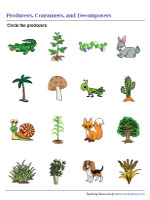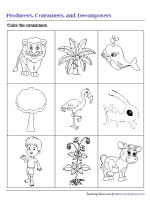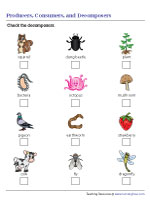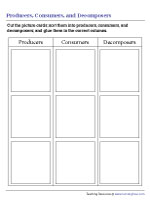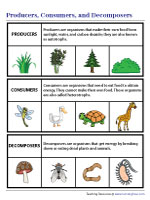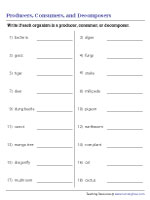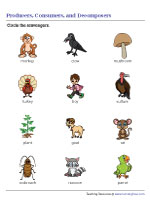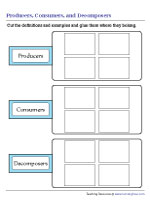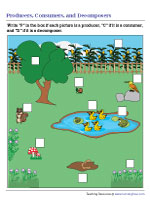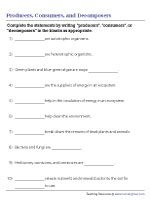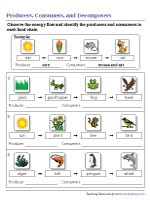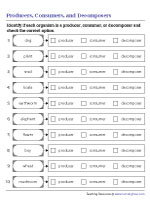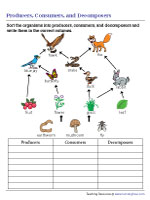Producers, Consumers, and Decomposers Worksheets
- Science >
- Producers, Consumers, and Decomposers
Our free, printable producers, consumers, and decomposers worksheets pay homage to our ecosystem that is so delicately balanced by the presence of organisms that belong to all three types. Producers deserve a pat on their back, for they produce food for themselves and other organisms. Consumers depend on other organisms for food, and decomposers get their food by breaking down the remains of dead animals. Remember these facts when answering our producers, consumers, and decomposers worksheets pdf.
Our producers, consumers, and decomposers pdfs are ideal for grade 3, grade 4, and grade 5 kids.
Although children in grade 3 and grade 4 will stumble upon producer organisms a lot as they traverse this worksheet, they'll also chance upon organisms that are not producers.
As human beings, we survive by consuming what other organisms produce, and in this way, we are the biggest consumers. Get 3rd grade and 4th grade kids acquainted with the topic by identifying organisms that are consumers.
The energy and matter that organisms leave in their remains are broken down by decomposers. Decomposing is how earthworms, for example, get their energy. Check the organisms that are examples of decomposers.
Sorting Producers, Consumers, Decomposers | Cut and Glue
This printable sorting producers, consumers, and decomposers worksheet is a cut-and-glue activity, where grade 4 and grade 5 kids become aware of the specific roles played by various organisms.
Producers, Consumers, and Decomposers | Chart
While the definitions are easy yet comprehensive, the examples are colorful and fun. Let the budding biologists swot up on a key topic with this printable chart.
Is It a Producer, Consumer, or Decomposer?
Write against the organisms "producer", "consumer", or "decomposer" after figuring how each gets its energy. With 18 organisms to correctly identify, the learning promise of this section is immense.
What do you call an animal that feeds on the remains of dead animals? A scavenger, a type of decomposer, consumes the soft tissues of dead animals. Task the 4th grade and 5th grade biologists with circling each scavenger in this pdf.
Defining Producers, Consumers, Decomposers | Cut and Glue
The distinguishing feature among producers, consumers, and decomposers is how they source their energy. Remember this as you cut and glue the definitions and examples here.
A bright and brilliant picture, where organisms pop up in every corner, takes center stage in this exercise, where kids write P for producers, C for consumers, and D for decomposers.
Completing Sentences with Producers, Consumers, and Decomposers
Spruce up practice with this pdf worksheet that tasks kids with reading the sentences and filling in the blanks with the words producers, consumers, or decomposers as appropriate.
Naming Producers & Consumers Based on Energy Flow
Interpret the sequence of energy flow to decipher which of the organisms are producers and which ones are consumers, before writing their names in the space provided.
Identifying the Types of Organisms
Instruct children to figure out the type of each organism, hone in on the appropriate option, and check it in this printable producers, consumers, and decomposers worksheet.
Classifying Producers, Consumers, and Decmposers
Observe the arrows and the organisms to get an idea of the role they play in the ecosystem. Sort them as producers, consumers, or decomposers and write their names in the columns.


